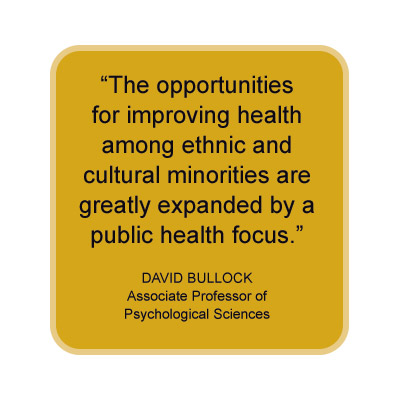Build a Healthier Society
College-wide initiative to focus on collaborative research and diverse learning opportunities

Tracking Disparities
Cleveland Shields, professor of human development and family studies, along with researchers at the universities of Rochester and Michigan, obtained a $2.7 million grant in 2011 from the National Institutes of Health (NIH) to study patient and physician communication. The goal is to help improve the interactions of physician visits, reduce disparities in service and increase patient involvement.
"The NIH study looks at patients who are very ill," Shields says. "We're using actors who are portraying patients. The physicians, who have signed a consent form, know they are going to see a 'fake' patient sometime. They just don't know when."
In unannounced and recorded visits (obtained through hidden audio devices), the researchers gain insight into improving patient-centered communication. Improved interactions between clinicians and all patients, regardless of their age, gender, ethnicity and personality characteristics, are critical for improving health outcomes.
With funding from the National Institute on Drug Abuse, Shields and Marianne Mathias, an adjunct faculty member at Indiana University-Purdue University Indianapolis, recently began examining physician-patient communication with non-cancer chronic pain patients at risk for abusing opioids.
Shields, also the director of the Center on Poverty and Health Inequities in Purdue's Regenstrief Center for Healthcare Engineering in Discovery Park, served on the curriculum committee for the evolving program. In 2016 he'll teach a course on health intervention methodology. By continuing to publish research and disseminating information through conferences and his work with the American Academy on Communication in Healthcare, Shields keeps those communication lines open.
Since he arrived at Purdue in 1988, David Rollock, associate professor of psychological sciences, has examined how minorities considered outside of the "American mainstream" have negotiated various social structures, including health care. As a member of a clinical program that produces some of the nation's top academic work, he is eager to collaborate with peers who complement his expertise.
"The opportunities for improving health among ethnic and cultural minorities are greatly expanded by a public health focus," he says. "Many of the issues that infringe on the health of ethnic minority communities, mental health in particular, have to do with factors that often aren't considered in direct service — matters like acculturation or exposure to discrimination. Better science informs better interventions, and we do science better when we understand human behavior in all of its particularities."
Rollock believes the diversity of the concentrations can entice young learners. Underrepresented students, for example, might be interested in health issues but not direct service. Or students could be interested in policy, systems of care or the legal issues related to health care.
Like Rollock, Yumary Ruiz (PhD '06), assistant professor of health and kinesiology, looks at health disparities across racial and ethnic lines, specifically migrant populations and its effects on Latino youths and their families. While earning her doctorate in health promotion and disease prevention, Ruiz taught MPH classes at Purdue and then joined the public health program at New York University.
Since returning to Purdue, Ruiz has embraced cross-disciplinary collaborators in social science research to explore methods for improving the human condition. She's eager to see how her work brings focus to the bigger picture.
"The thing you have to understand about public health is that we need to look at it from different spheres," says Ruiz, who thinks the opportunities could be even better. "As graduate students are exposed to faculty beyond a single department, those professors become phenomenal resources."











